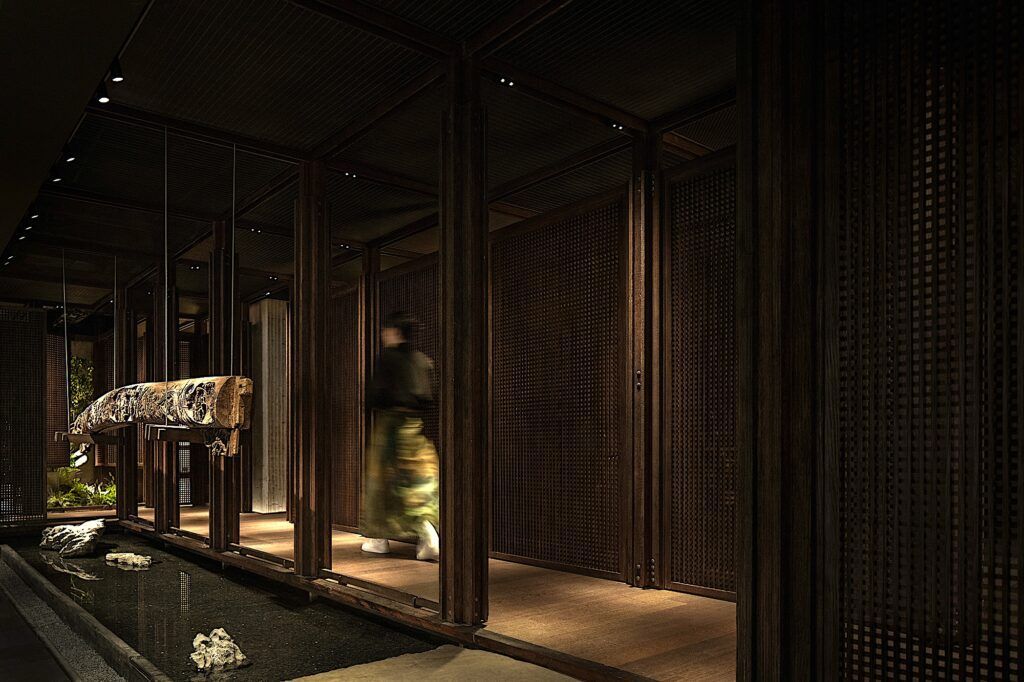Inspired by the ancient book “Changwuzhi”, also known as the Treatise on Superfluous Things, this tea space embodies the essence of antiquity, elegance, and seclusion. It conveys traditional Chinese literati’s sophisticated lifestyle and aesthetic sensibilities, while offering a sanctuary for savoring a leisurely and refined life. The tea space creates a peaceful ambiance, inviting guests to immerse themselves in the art of tea appreciation amidst picturesque surroundings.The space combines traditional oriental aesthetics with architectural culture, creating a natural, quaint, and elegant environment for enjoying tea, reminiscent of the pleasure derived from sipping tea amidst idyllic landscapes.Burn incense, sip tea, and engage in a conversation.Take in the view, admire utensils, and calm the mind.Upon stepping into the space, visitors are greeted by a serene water garden that creates a tranquil and calming atmosphere, perfect for meetings and gatherings. It offers a retreat secluded from the hustle and bustle of urban life, immersing guests in a distinct lifestyle amid mountains and rivers.Above the water pool is a Qing Dynasty beam, an essential component of ancient building structures, accompanied by stones sourced from Taihu Lake. It serves as the visual focus of the space and silently echoes the profound, extensive history of Beijing.As guests follow the light, the scenery changes with each step, leading to a different realm of time and space that evokes infinite imagination. The serene and luminous surroundings provide an idyllic setting of tranquil mountains and rivers. Guests are invited to indulge in the winding water features and engage in delightful conversations while enjoying a leisurely sip of tea.The long corridor is crafted using traditional mortise and tenon joints, showcasing the wisdom inherent in ancient architecture spanning millennia. The interconnected grill wooden doors near the pool blur reality and imagination, ushering visitors into three different tea rooms.The use of natural materials, original textures, elegant furnishings and utensils, along with plenty of unadorned spaces and simple lines, all indicate a return to a state of inner peace.Soft and warm yellow light leads guests towards elegant embellishments, such as the surrounding paintings, flowers, and miniature gardens, creating a serene atmosphere for enjoying the tea ceremony and connecting with others.The ancients crafted tatami tea tables of varying lengths and widths, all of which were charming and comfortable for sitting, lying, and leaning.As one leans on the tatami tea table by the window, the swaying shadows of the flowers and trees in the garden come into view, awakening all human senses in the embrace of such an elegant ambiance, creating a calm and relaxed state of mind.Without any kitsch, the tea room is enveloped in soothing incense that complements the aroma of tea, offering an immersive appreciation of the dim and implicit oriental aesthetic.The space features a subdued palette, complemented by elegant wooden furniture, sculptures from Ming and Qing dynasties and literati paintings. It serves as a haven for tea tasting, Zen meditation, and contemplation of life.The sparse leaves and textured tea utensils add a natural wild atmosphere and quaint elegance to the tea ceremony, offering a glimpse into ancient people’s affection for tea.Without complicated design interventions, the space features minimalist furnishings to nourish the soul, where the carved beams and antique walls appear like pieces of artwork.The windows frame beautiful views through landscaping techniques such as view borrowing and penetrating scenery. The grills, which are made using mortise and tenon joints, offer both a continuous and disconnected view. The sight extends from far to near, taking guests through the past and present, and gradually unveiling the beauty of the oriental aesthetic conception.In this tea space, the traditional Eastern aesthetic converges with contemporary humanity, capturing the essence of the Oriental poetry and inviting meditation and introspection amidst the aroma of tea.

